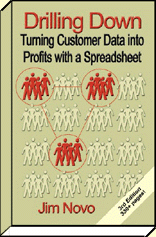
into Profits with a Spreadsheet
The Guide to Maximizing Customer Marketing ROI
Learn Do-It-Yourself Customer Analysis, Customer Modeling, and High ROI Customer Marketing TechniquesWhat exactly will you learn in this book? Glad you asked, and unlike most authors who tease and then don't deliver, I will tell you exactly what is in the book. If for some reason you don't believe any of this, just check out my background and read the testimonials. This 356 page edition of the Drilling Down book includes an additional 100 pages of reader questions answered by the author on applying the techniques learned in the book to specific business situations. The questions are organized into these categories: Definitions and Background Information These reader questions cover a wide range of industries such as publishing, facilities management, hospitality, education, call centers, professional services, manufacturing, telecommunications, retail, travel, banking & finance, enterprise software, automobiles, conference management, casino, and utilities. Introduction Chapter 1 Jonesin' for Some ROI These five chapters provide a basic introduction to the idea of customer modeling. Customer profiles and models are compared (they are not the same, but can work together!), and the fundamental ideas behind predicting customer behavior and customer value management are explained.
These chapters lay the foundation for your three simple customer model toolkits.
Each toolkit has an explanation of how and why the model works, provides examples, and then shows you step by step how to use the model to increase your profits. Chapter 6 Trip Wire Marketing Latency is the very simplest customer behavior model there is, and is very intuitive. If you know who some of your best customers are and have thought to yourself, "Gee, it has been a while since best customer X has been in" you are thinking about Latency. Your thought process is correct; but you have no method for determining when "been a while" means "they are not coming back," and you have no specific action plan to turn your thoughts into increased profits. The Latency toolkit shows you how to measure Latency and set up "trip wires" that will tell you how to increase the profitability of your marketing. Latency is often the preferred model to use in service-oriented businesses where there is a monthly billing arrangement or other "built-in reason" for repeat activity such as with utilities, insurance, telecommunications, and personal services such as hair salons. Take
the Latency Tutorial Chapter 10 Predictive Marketing Recency is just a bit more complex than Latency, because it involves ranking customers against each other versus creating a simple "trip wire" for all of your customers. The Recency approach creates a more finely tuned model, allowing you to segment and target customers with more accuracy and drive profits even higher than you can with Latency. The Recency Toolkit builds on your knowledge of Latency and shows you how in some cases, using Latency and Recency together generates the highest increase in profits. Recency is particularly effective in maximizing the margins of promotional programs, often making it the preferred model for retail oriented businesses, ad-supported web sites, and other businesses lacking "built-in reasons" for repeated customer activity over time. Take
the Recency Tutorial Chapter 14 Cash Flow Marketing Predictive marketing is proactive, meaning you predict the likelihood of future events based on customer models, where each customer is given a "score." These scores rank customers against each other for likelihood to respond, to defect from your business, to become a high value customer, and so forth.
Don't get nervous about the word "model"; it's not some kind of black box thing you can't understand.
If you can use a spreadsheet (or write some simple code), you can create these customer scores using a
model called RFM. RFM Scores tell you which customers are drifting away, getting ready to leave you, and determine whether it will be profitable for you to act to try and keep the customer RFM Scores tell you what best customers like and what they don't like RFM Scores tell you how to make more money by allocating resources where you will drive the most profitable activity More
Details On RFM Chapter 20 Customer Characteristics & Multiple Scores Learn how to use multiple behavior rankings together with demographics to rank the ability of ads, products, services, and content to generate the most profitable customers. Combine RFM with Latency to produce an incredibly powerful customer value management tool - Customer LifeCycle Grids. The Grids are visual maps of customer retention and defection you can use as the "master plan" for managing your entire customer marketing effort. Spot high ROI customer groups coming in the front of the business and plan ahead for multi-step defection campaigns at the back of the business with counts of customers in the various stages of defection - track, manage, and profit from the Customer LifeCycle. More
Details on the Customer LifeCycle Chapter 25 Fellow Drillers at Work Jim invites owners of the book to e-mail specific questions on using the
customer models and techniques in Drilling Down. These questions
have been organized into the functional categories above, and cover a
wide range of industries such as publishing, facilities management,
hospitality, education, call centers, professional services,
manufacturing, telecommunications, retail, travel, banking &
finance, enterprise software, automobiles, conference management,
casino, and utilities. Chapter 26 Predicting Campaign ROI: Set Up Those interested in nailing the topic of ROI right between the eyes will learn how to use your scoring techniques to optimize every customer campaign to generate the most acceptable mix of sales and profits, and predict the ROI of a promotion before you even send it out! There's more! Automate the basic customer scoring process on large groups of customers. Use the software included free with the complete edition of the book. Windows OS and MS Access and Excel required to run the Drilling Down software application. |
|
|
|
Slow connection? Same content, less graphics, think Jakob Nielsen in Arial - Go to faster loading website Contact me
(Jim Novo) for questions or problems with anything on this web site.
| |
![]()
|
Get the book with Free scoring software at Booklocker.com Find Out Specifically What is in the Book Learn Customer Marketing Concepts and Metrics (site article list)
|
|
|
